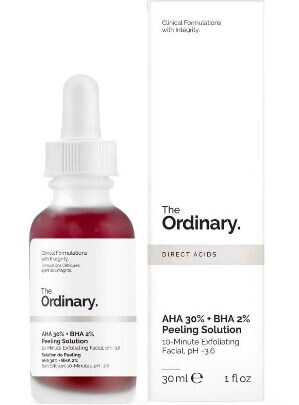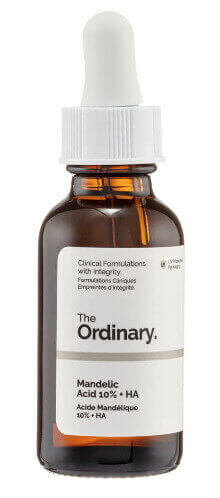
In an article in Women’s Health, skin health expert Jane Scrivner said the following:
There is an inaccurate assumption that Alpha Hydroxy and Beta Hydroxy Acids shouldn’t be used on black and darker skin as they contribute to pigmentation issues. However, when used correctly, these acids work fabulously on black skin and Fitzpatrick 4-6 skin types.
Alpha Hydroxy Acid (AHA)
In my post on mandelic acid for darker skin tones, I mentioned that it is one of the three main types of alpha hydroxy acids (AHAs). The others being glycolic acid and lactic acid. AHAs are one of the most frequently recommended exfoliating ingredients in modern skin care.
Other lesser know AHAs that are frequently found in skin-care products include citric acid, malic acid and tartaric acid. All three of those are derived from fruits and sometimes referred to as fruit acids.
Glycolic acid (derived from sugarcane) is the most intense of these AHAs. It has the smallest molecular size, allowing it to penetrate the skin easily. If you have darker skin, you must be careful in the strength of glycolic acid that you use. Some dermatologists might not even recommend using it in your peel. Lactic acid is derived from fermented milk or synthetically.
AHAs are great at treating mild hyperpigmentation, including age spots, melasma, scars and uneven skin tone. However, if you have sensitive skin, AHAs can cause irritation. Most dermatologists recommend not using formulas with concentrations higher than 15 percent. AHAs in most cosmetic products operate at around a pH level of between 3 and 5.
Beta Hydroxy Acid (BHA)
Beta hydroxy acids (BHAs) are a class of mild acids that are especially popular for skin exfoliation and in treating acne. There is only one beta hydroxy acid that is commonly used in skin care products, and that is called salicylic acid. It is derived from aspirin. BHA in cleansers, lotions and moisturizers works best at a concentration level of 1% to 2% and at a pH of 3 to 4. Per wikipedia, salicylic acid is used to treat warts, psoriasis, acne vulgaris, ringworm, dandruff, and ichthyosis.
The Ordinary Peeling Solution AHA 30% + BHA 2%
Perhaps the most popular peeling product on Amazon that contains both AHA and BHA is “The Ordinary Peeling Solution AHA 30% + BHA 2%”. It currently has a massive 37,000 reviews averaging 4.5 out of 5 stars. Moreover, it only costs $9.50. You cannot beat that price for such a popular product.
Note that “The Ordinary” is a brand from DECIEM. On the company’s website, this combination AHA plus BHA product is advertised as suited for all skin types. The average rating there is an even higher 4.7 out of 5 stars.
The directions for use on the face contain some warnings in order to prevent side effects.
- Use no frequently than twice per week in order to avoid skin irritation.
- Do not use on wet skin.
- Apply evenly across face and neck using your fingertips.
- Leave on for no more than 10 minutes.
- Avoid any contact with the eyes during both application and rinse off.
- Do not leave on for longer than 10 minutes.
- The AHA in this product may increase your skin’s sensitivity to the sun and susceptibility to sunburn. Use a sunscreen and limit sun exposure while using this product.
The Difference Between Alpha Hydroxy Acids and Beta Hydroxy Acids
While both AHAs and BHAs work in a smilar manner, they differ in how they penetrate your skin. Alpha hydroxy acids are water-soluble chemicals that aid in the removal of dead skin cells. However, they can not go into the deep pores of your skin.
In contrast, beta hydroxy acids are lipid-soluble, meaning that they will dissolve in oil. Consequently, BHAs are able to penetrate into the skin pores where you have oily sebum buildup. BHAs can therefore exfoliate the dead skin cells that build up inside these pores and around hair follicles. Beta hydroxy acid are more suitable for those with oily skin that contains blackheads and whiteheads.
